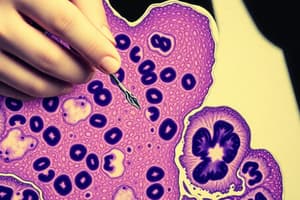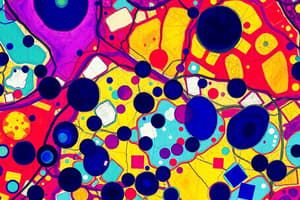Podcast
Questions and Answers
What is the primary aim of a histology course?
What is the primary aim of a histology course?
- To focus on macroscopic anatomy only
- To discuss various staining techniques only
- To understand the microanatomy of cells, tissues, and organs (correct)
- To teach about the evolution of tissues
What type of stain is used for staining living structures in a living animal?
What type of stain is used for staining living structures in a living animal?
- Neutral stain
- Metachromatic stain
- Supravital stain (correct)
- Acidic stain
Which type of microscope has the highest resolution power?
Which type of microscope has the highest resolution power?
- Electron microscope (correct)
- Phase contrast microscope
- Optical microscope
- Light microscope
What characteristic defines metachromatic stains?
What characteristic defines metachromatic stains?
Which stain would be classified as basic and is used to stain acidic structures?
Which stain would be classified as basic and is used to stain acidic structures?
What is the maximum magnification power of a light microscope?
What is the maximum magnification power of a light microscope?
What is the resolution power of the human eye?
What is the resolution power of the human eye?
What does the term 'resolution power' refer to?
What does the term 'resolution power' refer to?
Which type of stain is a combination of acidic and basic stains?
Which type of stain is a combination of acidic and basic stains?
What is the primary function of acidic stains in histology?
What is the primary function of acidic stains in histology?
Flashcards are hidden until you start studying
Study Notes
Histology:
- The study of the microscopic structure of normal tissue.
- Aims to understand the microanatomy of cells, tissues, and organs.
- Focuses on correlating structure with function.
Microscopy in Histology:
- Uses different types of microscopes to study tissues.
- Light microscope (LM): Commonly used, has a resolution power of 0.2µm and a maximum magnification of x1000.
- Electron microscope (EM): Offers higher resolution power (0.2nm) and magnification (x100,000) compared to the LM.
- Resolution power: The ability to distinguish two separate points, measured as the minimum distance needed for them to appear as distinct entities.
Staining Techniques:
- Cells are normally colorless and difficult to distinguish without staining.
- Acidic stains: Stain basic structures, making them appear acidophilic (e.g., eosin).
- Basic stains: Stain acidic structures, making them appear basophilic (e.g., hematoxylin).
- Neutral stains: Combination of acidic and basic stains, suitable for staining blood cells (e.g., Leishman's stain).
- Vital stains: Used to stain living structures within a living organism (e.g., trypan blue or India ink for phagocytic cells).
- Supravital stains: Used to stain living cells outside a living organism (e.g., Brilliant Cresyl blue for reticulocytes).
- Metachromatic stains: Produce a new color upon staining, different from the original stain color, due to a chemical reaction with specific structures within the cell (e.g., toluidine blue stains mast cell granules with violet color).
- Orcein stain: Stains elastic fibers brown.
- Silver stain: Stains reticular fibers brown or black, also used to demonstrate the Golgi apparatus.
- Osmic acid: Stains myelin sheath black.
- Histochemical & cytochemical stains: Used to localize and demonstrate certain substances within a tissue or cell based on biochemical reactions.
- Glycogen: Stained red by Best's carmine.
- Lipids (fat): Stained black with Sudan black and orange with Sudan III.
- Enzymes: Stained using specialized methods (e.g., acid and alkaline phosphatase enzymes).
Studying That Suits You
Use AI to generate personalized quizzes and flashcards to suit your learning preferences.




